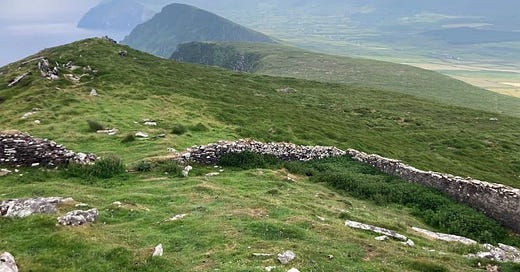[Note: this article originally appeared on Intellectual Takeout]
The average autochthonous Irishman is close to patriotism because he is close to the earth; he is close to domesticity because he is close to the earth; he is close to doctrinal theology and elaborate ritual because he is close to the earth. In short, he is close to the heavens because he is close to the earth.
G.K. Chesterton wrote this in his book on George Bernard Shaw, and, as usual, the English writer hit at the essence of his subject with just a few words. I was recently in Ireland, and one of the things that struck me most during my visit was the centrality of the landscape.
With just a glance, it’s clear that the Irish were rooted in the earth, and this shaped their culture—though all of that appears to be changing. Nevertheless, a look at traditional Irish culture and its remnants offers valuable insights into our own country and its current culture wars.
When we think of Ireland in America, we think of green fields dotted with sheep and dramatic cliffs plummeting into a roiling ocean. And rightfully so. The scenery of the Emerald Isle steals your breath, and pictures do not do it justice.
Every region in the country offers a new kind of beauty: from great, rocky mountains sweeping down to the sea and crisscrossed by Iron Age stone fences to hidden valleys concealing crystalline lakes and mossy ruins. The variety is as remarkable as the qualities of each, with some regions reminding me of Montana, others of my native Wisconsin, and others presenting something completely unfamiliar.
But most significantly, the buildings in Ireland enhance the natural beauty, rather than detracting from it. Each village, down to the last cottage, seems to have been built with a strong aesthetic sense and an awareness of place.
The buildings are not modern, generic contraptions stuck pragmatically and inharmoniously into a landscape that could be anywhere. No, they are part of that landscape, as integral to it as the trees and streams themselves.
One reason for this is that many of the buildings are very old and were built from the same rock that protrudes from the mountainsides—the material that was at hand. This was long before the days of mass-produced and imported construction materials. The earth of Ireland is in its buildings, just as the buildings are in the earth. It can be hard to tell where the stone wall ends and the hillside begins, where the forest terminates and the hedge originates. One grows organically (sometimes literally) out of the other.
This is a country that was built in harmony with the landscape. Yet, at the same time, the human dwellings are distinct from their surroundings and bring a clearer order to the natural environment. For instance, the cathedral spires that rise up out of woodlands are nature-inspired in shape and spirit but clearly something apart from and above nature.
And herein, maybe, lies something of traditional Irish wisdom: this knowledge that the very definition of human civilization is to bring order to nature without destroying it.
Pure nature is chaos, savagery, but we might say the steamrolling of nature is a trademark of modern technological barrenness. Irish civilization, at one time, found that happy middle ground of taming the wild without abandoning the natural foundations of human life.
As Chesterton also noted, Ireland traditionally possessed a great number of small family farms, which are still visible throughout the countryside, even if no longer functioning as such. This is another way that the earth featured centrally in Irish culture—not just as the backdrop for daily life but as its very source through its production of food for both animals and humans.
Few occupations provide a better connection to the rhythms of nature, the seasons, birth and death, and our dependence on all these things than traditional farming. This is what Chesterton means when he says the Irish were “close to the earth.” And he’s right that such closeness provides a solid foundation for culture.
The link between healthy agriculture and healthy culture runs deep and is attested to in our very language. According to the Oxford English Dictionary, the word culture derives from the Latin cultura, meaning “cultivation, tillage, piece of cultivated land, care bestowed on plants” through the French culture, meaning “action of cultivating land, plants, etc., husbandry” and also “formation, training” and “worship or cult of someone or something.”
In most civilizations, what we call culture begins as the worship of some higher power in thanksgiving and petition for agricultural fruitfulness. These songs, prayers, and celebrations bring people together, solidifying community and inspiring further reflections and works of art.
Society becomes not just a cultivation of plants and animals but a cultivation of arts and sciences and religion. Dr. Anthony Esolen, in his book Out of the Ashes: Rebuilding American Culture, puts it this way: “For the role of religion in human life is not little. It is essential: without it there is no culture at all, because culture is a cultivation of the things that a people considers most sacred.” Thus religion, farming, and culture are fundamentally bonded.
A society that remains aware of its dependence on the land for its continued existence and that celebrates that bounty has strong roots and can flourish in its cultural branches, like a tree. The constant contact with the firm, often harsh reality of the natural world keeps the society grounded. Then, and only then, can human society safely rise higher, like an Irish church, reaching toward the heavens.
[Photo credit: Katie Coppernoll]



